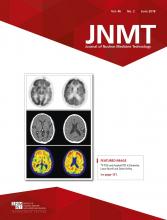Abstract
This article is the second part of a continuing education series reviewing basic statistics that nuclear medicine and molecular imaging technologists should understand. In this article, the statistics for evaluating interpretation accuracy, significance, and variance are discussed. Throughout the article, actual statistics are pulled from the published literature. We begin by explaining 2 methods for quantifying interpretive accuracy: interreader and intrareader reliability. Agreement among readers can be expressed simply as a percentage. However, the Cohen κ-statistic is a more robust measure of agreement that accounts for chance. The higher the κ-statistic is, the higher is the agreement between readers. When 3 or more readers are being compared, the Fleiss κ-statistic is used. Significance testing determines whether the difference between 2 conditions or interventions is meaningful. Statistical significance is usually expressed using a number called a probability (P) value. Calculation of P value is beyond the scope of this review. However, knowing how to interpret P values is important for understanding the scientific literature. Generally, a P value of less than 0.05 is considered significant and indicates that the results of the experiment are due to more than just chance. Variance, standard deviation (SD), confidence interval, and standard error (SE) explain the dispersion of data around a mean of a sample drawn from a population. SD is commonly reported in the literature. A small SD indicates that there is not much variation in the sample data. Many biologic measurements fall into what is referred to as a normal distribution taking the shape of a bell curve. In a normal distribution, 68% of the data will fall within 1 SD, 95% will fall within 2 SDs, and 99.7% will fall within 3 SDs. Confidence interval defines the range of possible values within which the population parameter is likely to lie and gives an idea of the precision of the statistic being measured. A wide confidence interval indicates that if the experiment were repeated multiple times on other samples, the measured statistic would lie within a wide range of possibilities. The confidence interval relies on the SE.
- research methods
- statistical analysis
- statistics
- accuracy
- standard deviation
- statistics
- technologist
- variance
Footnotes
Published online Feb. 2, 2018.
CE credit: For CE credit, you can access the test for this article, as well as additional JNMT CE tests, online at https://www.snmmilearningcenter.org. Complete the test online no later than June 2021. Your online test will be scored immediately. You may make 3 attempts to pass the test and must answer 80% of the questions correctly to receive 1.0 CEH (Continuing Education Hour) credit. SNMMI members will have their CEH credit added to their VOICE transcript automatically; nonmembers will be able to print out a CE certificate upon successfully completing the test. The online test is free to SNMMI members; nonmembers must pay $15.00 by credit card when logging onto the website to take the test.







